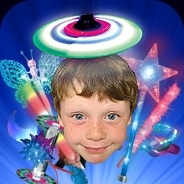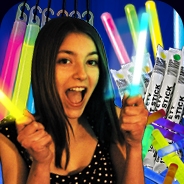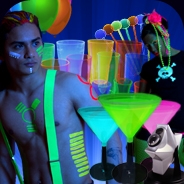10 Things that you didn’t know about Glowsticks

• Download/Print PDF File (Home Print 312k)
• Download/Print PDF File (Hi Res Press Print with 3mm bleed 13.2mb)
Often associated with parties and large social events, there’s much more to your humble glowstick than meets the eye! Did you know that…?
1. Chemical Reaction
Glowsticks are a chemical reaction going off in a tube! The glow released by a glowstick is the result of a chemical reaction taking place. Hydrogen peroxide sits in a glass vial that’s floated in tert butyl alcohol and fluorescent dye. When you crack a glowstick, you break the vial allowing the chemicals to mix causing a chemical reaction, the side effect of this is light without heat which causes the glowstick to glow and the process is known as chemiluminescence.
2. Invented by the Military
Glowsticks were originally invented as a military tool. Developed by the US Navy in the early sixties, glowsticks began life as emergency lights, man overboard float lights, target markers, landing zone markers and parachute drop markers before being picked up by further arms of the military and public services and eventually civilian markets.
3. Affected by Temperature
Glowsticks are affected by temperature. The chemical reaction inside a glowstick is sensitive to heat and extreme cold. The speed of the chemical reaction speeds up considerably in high temperatures causing the glowstick to glow brighter but for a shorter period of time. Exposure to extreme cold and freezing conditions dramatically slows down the chemical reaction resulting in a duller glow that lasts much longer than usual, so if you want to prolong the life of your glowstick, pop it in the freezer!
4. Various Shapes and Sizes
Glowsticks are available in more than just one shape. The standard six inch glowstick is the most recognised shape, but the same concept has been applied to make glow necklaces, glow bracelets, glow cups and even glow in the dark bunny ears!
5. Green and Yellow Glow the Brightest
Green or yellow glowsticks are typically the brightest glowing colours followed by orange, so go for these if you’re using glowsticks for visibility or emergency beacons. These colours are the purest and therefore the brightest as they contain less fluorescent dye than other colours.
6. Cannot Be Turned Off
A glowstick cannot be turned off or reused once activated. Once you start the chemical reaction it can only be slowed be placing in extreme cold but will not stop entirely. A glowstick will glow until the chemical reaction is complete.
7. Safe Light Source
Glowsticks are a safe light source. Glowsticks provide light without heat or sparks which makes them the only light source that’s safe to use in emergencies and natural disasters. Glowsticks use non toxic chemicals and are non flammable.
8. Two Year Shelf Life
Glowsticks have a shelf life of as much as two years before they’re activated!
9. Endless Uses
Glowsticks have endless uses and are popular for use in all walks of life. From camping, to diving, potholing, emergency beacons, landing markers to party favours and even fishing lures!
10. 12hr+ Glow
Glowsticks will typically glow for up to twelve hours, although some colours have been known to go on for twenty-four!





